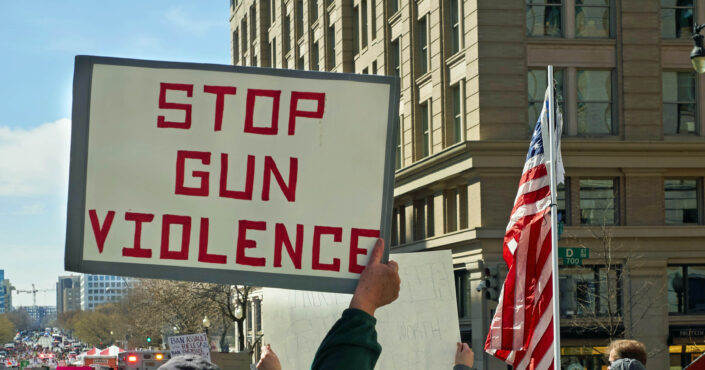Guns are an accepted part of American society and culture, and we often hear news about gun violence, including horrific mass shootings. Nurses are on the front lines of healthcare, so understanding guns and gun violence is an important part of being a nurse in the 21st century.
The Reality of Guns and Gun Violence
Whether working directly with patients or serving in non-clinical roles, nurses are positioned to educate others about public health and safety. The American Nurses Association (ANA) and other organizations clearly state that violence is a public health issue that can directly affect citizens of every age.
It’s estimated that 81.4 million Americans aged 18 or older own guns, with over 40% of households containing at least one gun.(1,2) About one-third of firearms in civilian hands worldwide belong to American citizens, and there are approximately 400 million guns in the U.S., with 393 million owned by civilians.(3) Additionally, the Gun Violence Archive reported 387 mass shootings in the U.S. as of August 1, 2022, depending on how a mass shooting is defined.
According to the Centers for Disease Control (CDC), gun-related homicides increased 35% between 2019 and 2020, and the 2020 firearm homicide rate was the highest in over 25 years. The CDC also reported that 53% of all suicides and 79% of all homicides in 2020 involved guns.
Nurses on the Front Lines
All hospitals may have security, but with multiple entrances and hundreds or thousands of people coming and going throughout the day and night, the risk of gun violence is real.
A National Library of Medicine study on hospital-based shootings between 2000 and 2011 showed that there were 154 hospital-based shootings, including 91 inside the hospital and 63 outside on hospital grounds. These shootings happened in 40 states, and 235 people were injured or killed. Hospital workers made up 20% of the victims. Nurses and their colleagues in emergency departments are especially vulnerable to gun violence, with 29% of these shootings occurring inside an E.D.
No matter how “rare” the media portrays hospital shootings, the risk and fear of violence remains. Active shooter drills are the norm, and every nurse hopes they never need to put those skills into practice.
Nurses, Patients and Guns
There will always be gun injuries to which nurses must respond. Gun violence happens, and nurses are the ones who provide direct bedside care. In this respect, nurses who work in trauma, the ED and the OR must understand the nature and care of gunshot wounds.
As public health advocates, nurses are within their scope of practice to discuss gun safety with patients. Many healthcare facilities include gun ownership and safety questions on their intake forms. Especially in pediatrics, providers want to know that guns are properly stored and out of the reach of children.
Organized groups of nurses, like Nurses Against Violence Unite, advocate against violence, and the Emergency Nurses Association released an official statement about the gun violence epidemic in 2019. Nurses are free to rally and call for change outside of work, but they must set aside their personal views and opinions when caring for patients.
Patients should never feel judged for their gun views or for owning guns. Guns can always be discussed between a nurse and patient, but never the politics of guns or gun ownership. If a patient raises the issue, it’s always best for the nurse to reflect on the patient’s feelings, ask pertinent questions and redirect the conversation away from politics or morality.
Vicarious Trauma
There have been many articles and reports on the vicarious trauma experienced by nurses during the COVID-19 pandemic. However, the secondary trauma from gun violence should not be overlooked. Traumatic stress is a reality for many healthcare workers, and how we respond to the problem matters.
For nurses who have direct contact with victims of gun violence — or violence of any kind — the availability of mental health counseling, crisis debriefing and emotional support is crucial. Nurses can become numb to the pain of exposure to the results of violence. Still, secondary trauma can take a toll, and smart employers will ensure that services are accessible to staff who need them.
Nurses Will Always be There
No matter what happens on the federal or state level, nurses will be there to care for those who are injured, in pain and traumatized. Guns and gun violence may be here to stay, but so are millions of nurses.
When we face the reality of gun-related violence in the United States today, nurses must understand the facts, form their own opinions and continue to provide high-level professional nursing care to those in need. No matter what divides us, the suffering caused by guns must be relieved, and nurses will always be there to do just that.
Losing a patient whether to gun violence or for any reason can be difficult to overcome. Read our guide on Dealing with Death as a Nurse for guidance and resources, including advice from several nurses with firsthand experience.
- SSRN.com, 2021 National Firearms Survey by William English
- NORC.org, One in Five American Households Purchased a Gun During the Pandemic by John K. Roman
- smallarmssurvey.org, Global Firearms Holdings









